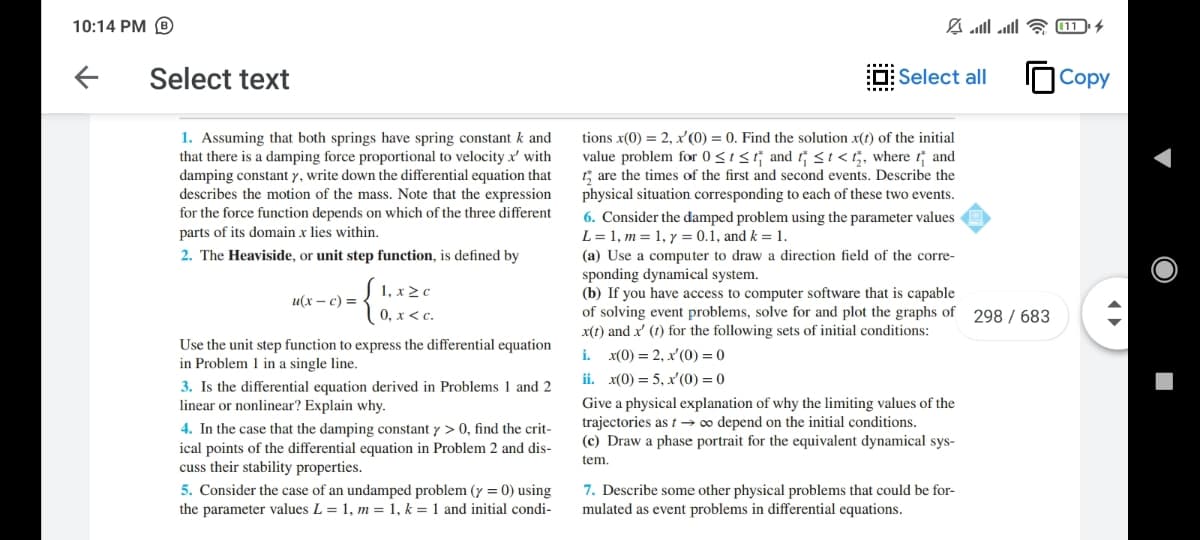3. Is the differential equation derived in Problems 1 and 2 linear or nonlinear? Explain why.
3. Is the differential equation derived in Problems 1 and 2 linear or nonlinear? Explain why.
Advanced Engineering Mathematics
10th Edition
ISBN:9780470458365
Author:Erwin Kreyszig
Publisher:Erwin Kreyszig
Chapter2: Second-order Linear Odes
Section: Chapter Questions
Problem 1RQ
Related questions
Topic Video
Question
Solve Q3

Transcribed Image Text:10:14 PM B
Select text
O: Select all
Copy
1. Assuming that both springs have spring constant k and
that there is a damping force proportional to velocity x' with
damping constant y, write down the differential equation that
describes the motion of the mass. Note that the expression
for the force function depends on which of the three different
parts of its domain x lies within.
tions x(0) = 2, x'(0) = 0. Find the solution x(t) of the initial
value problem for 0<1< and si<5, where t and
t; are the times of the first and second events. Describe the
physical situation corresponding to each of these two events.
6. Consider the damped problem using the parameter values
L = 1, m = 1, y = 0.1, and k = 1.
2. The Heaviside, or unit step function, is defined by
(a) Use a computer to draw a direction field of the corre-
sponding dynamical system.
(b) If you have access to computer software that is capable
of solving event problems, solve for and plot the graphs of 298 / 683
x(1) and x' (1) for the following sets of initial conditions:
1, x2 c
0, x < c.
и(х — с) 3D
Use the unit step function to express the differential equation
in Problem 1 in a single line.
i. x(0) = 2, x'(0) = 0
ii. x(0) = 5, x'(0) = 0
3. Is the differential equation derived in Problems 1 and 2
linear or nonlinear? Explain why.
Give a physical explanation of why the limiting values of the
trajectories as t → o depend on the initial conditions.
(c) Draw a phase portrait for the equivalent dynamical sys-
4. In the case that the damping constant y > 0, find the crit-
ical points of the differential equation in Problem 2 and dis-
cuss their stability properties.
5. Consider the case of an undamped problem (y = 0) using
the parameter values L = 1, m = 1, k = 1 and initial condi-
tem.
7. Describe some other physical problems that could be for-
mulated as event problems in differential equations.
Expert Solution
This question has been solved!
Explore an expertly crafted, step-by-step solution for a thorough understanding of key concepts.
This is a popular solution!
Trending now
This is a popular solution!
Step by step
Solved in 2 steps

Knowledge Booster
Learn more about
Need a deep-dive on the concept behind this application? Look no further. Learn more about this topic, advanced-math and related others by exploring similar questions and additional content below.Recommended textbooks for you

Advanced Engineering Mathematics
Advanced Math
ISBN:
9780470458365
Author:
Erwin Kreyszig
Publisher:
Wiley, John & Sons, Incorporated

Numerical Methods for Engineers
Advanced Math
ISBN:
9780073397924
Author:
Steven C. Chapra Dr., Raymond P. Canale
Publisher:
McGraw-Hill Education

Introductory Mathematics for Engineering Applicat…
Advanced Math
ISBN:
9781118141809
Author:
Nathan Klingbeil
Publisher:
WILEY

Advanced Engineering Mathematics
Advanced Math
ISBN:
9780470458365
Author:
Erwin Kreyszig
Publisher:
Wiley, John & Sons, Incorporated

Numerical Methods for Engineers
Advanced Math
ISBN:
9780073397924
Author:
Steven C. Chapra Dr., Raymond P. Canale
Publisher:
McGraw-Hill Education

Introductory Mathematics for Engineering Applicat…
Advanced Math
ISBN:
9781118141809
Author:
Nathan Klingbeil
Publisher:
WILEY

Mathematics For Machine Technology
Advanced Math
ISBN:
9781337798310
Author:
Peterson, John.
Publisher:
Cengage Learning,

